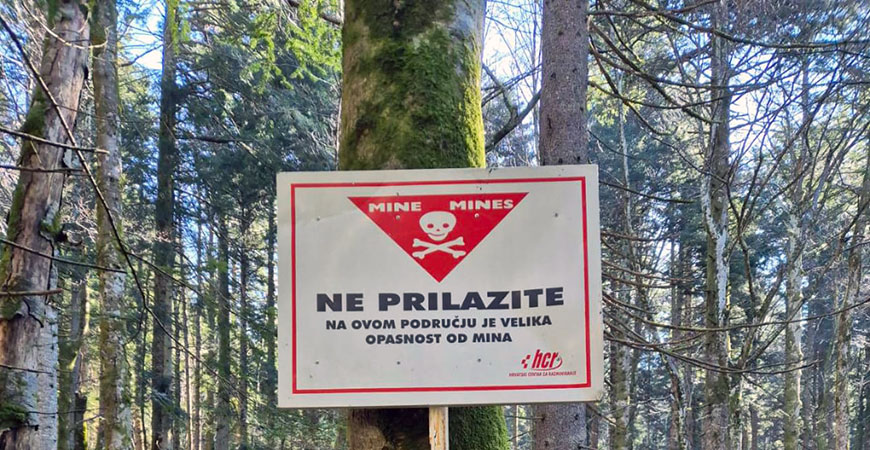
More than 100 million land mines remain buried around the world, posing a threat in approximately 70 countries and territories, and killing or injuring about 5,000 people, most of them civilians, every year.
As the world’s geopolitical landscape shifts, nine scientists studying different aspects of warfare ecology from seven countries — Poland, Ukraine, Norway, Spain, the United States, Finland and Croatia — are warning against the growing deployment of land mines as countries bordering Russia withdraw from global conventions restricting their use.
 “Land mines leave a lasting legacy of death and misery, destruction of communities and environmental impacts long after wars have ended, but if you don't have connections with countries that are directly affected by war, you would never hear about this. It is not the kind of news that typically makes it to the evening news,” said UC Merced Professor Asmeret Asefaw Berhe, who co-wrote a letter published in the journal Science.
“Land mines leave a lasting legacy of death and misery, destruction of communities and environmental impacts long after wars have ended, but if you don't have connections with countries that are directly affected by war, you would never hear about this. It is not the kind of news that typically makes it to the evening news,” said UC Merced Professor Asmeret Asefaw Berhe, who co-wrote a letter published in the journal Science.
“We are trying to warn the world about how the global community is turning back a lot of the progress that had been made over the past 50 years, especially on land mines and other unexploded ordnance.”
With their letter, the scientists are imploring all countries to take more “measured approaches to national defense and stop undermining the goals of a mine-free world, environmental conservation and human welfare.”
Former Secretary-General of the United Nations Boutros Boutros-Ghali called land mines a persistent reminder of the horrors of war, Berhe said, in part because in the mid-1990s, at the height of the land mine crisis, between 500 and 800 people a week were killed by mines, with another 1,000 or so injured.
Globally, more people have been killed and injured by land mines than by all biological and chemical weapons combined. Further, these weapons remain in the ground for decades after wars end, restricting communities’ access to their land, causing physical disruptions to and chemical contamination of soil, limiting the productivity of land and contributing to a global land degradation crisis.
In March, the Baltic states — Lithuania, Latvia and Estonia — and Finland and Poland declared plans to withdraw from the Ottawa Treaty or Anti-Personnel Mine Ban Convention and Lithuania withdrew from the Convention on Cluster Munitions. These actions signal that the countries might produce, stockpile, trade and deploy these weapons.
While these countries may feel they can better protect themselves from the possible encroachment of Russia and other countries as global geopolitics shift, the scientists said that risks to both humans and the environment far outweigh any benefits.
“Land mines are very long-lasting, and they are very cheap. They cost about $3 each,” Berhe said. “But they are incredibly hard to remove from the ground once they have been buried.”
Outside of the damage they cause when they explode, clearing land mines has a significant impact on surrounding ecosystems, Berhe said. It's also expensive to de-mine an area — it costs about $1,000 per mine.
Berhe, a biogeochemist, the Ted and Jan Falasco Chair in Earth Sciences and Geology and the faculty director of the Sierra Nevada Research Institute, has been researching and publishing on the global crisis of land mine-caused land degradation for more than two decades, since she was a master’s student at Michigan State University.
Several animal species have been pushed to the brink of extinction around the world because of land mines, and many other species in affected countries are at risk, she said. Additionally, land mines are composed of metals and toxic explosive materials that contaminate the surrounding ground.
“The environmental implications of land mines are profound, and scholars studying the environmental impacts of wars argue that we shouldn't separate the humanitarian and environmental impacts because they are so closely interrelated,” Berhe said.
Deployment of indiscriminate weapons at Europe’s eastern borders would complicate not only ecological monitoring but also exclude people from the landscapes they use and steward, the scientists said. The UN secretary-general and the UN high commissioner for human rights have issued statements about how risks linger long after conflicts, affecting farmland, playgrounds and homes.
As of March, the Ottawa Treaty had 164 signees. This international treaty aims to eliminate the use, production, stockpiling and transfer of anti-personnel mines. It also mandates the destruction of existing stockpiles and the clearance of mined areas, while also assisting land mine victims.
To date, 123 signatories have committed to the goals of the Convention on Cluster Munitions, which prohibits all use, production, transfer and stockpiling of cluster munitions.
However, some of the major powers have not joined either treaty, including the United States, Russia and China, meaning the treaties’ provisions do not legally bind them.



